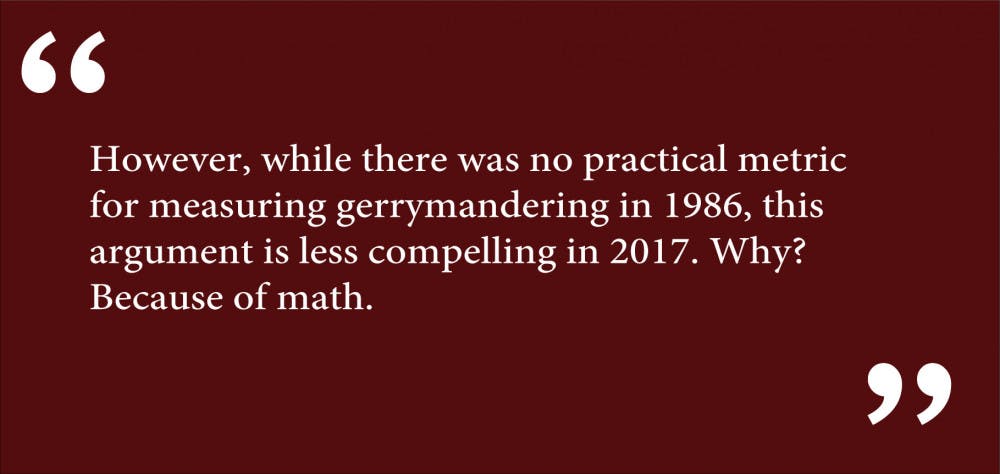Near the end of the Supreme Court’s oral argument in Gill v. Whitford, a case on the constitutionality of partisan gerrymandering, the court’s most junior justice, Justice Neil Gorsuch, began peppering the petitioner with questions. Where, exactly, in the Constitution was the provision that allowed the court to force states to redraw their district lines, he asked, in not so few words. Justice Ruth Bader Ginsburg responded with the justices’ equivalent of a suplex: “Where did one person one vote come from?” Gorsuch did not ask any more questions for the remainder of the oral arguments.
While most Americans familiar with the episode probably see it as another step in Ginsburg’s cultural apotheosis to be enjoyed briefly on Buzzfeed, her argument is one that has hounded the court for decades. If the Supreme Court has previously embraced a principle of “one person, one vote,” which it did all the way back in 1964, why is it that North Carolina has 10 Republican representatives out of 13 when only 50 percent of the population voted for congressional Republican candidates? In fact, the court recognized in the 1986 case Davis v. Bandemer, that it had constitutional authority to intervene in cases of partisan redistricting, but refused to do so without some clear metric with which to inform their decision. The court held again in the 2004 case Vieth v. Jubelirer that it simply cannot rule on gerrymandering because there is simply no fair, practical way for the court to resolve these questions. However, while there was no practical metric for measuring gerrymandering in 1986, this argument is less compelling in 2017. Why? Because of math. And in fact, the court should use math to put an end to gerrymandering once and for all.
In recent years, as gerrymandering has garnered more attention from the public and the news media, social scientists have begun to analyze partisan redistricting with more scrutiny. Many have even proposed solutions. Mathematicians like Jonathan Mattingly have developed computer software that is capable of cross-referencing thousands of maps along with relevant voting data. From the data, one is able to compare actual districts and their electoral outcomes with randomized districts or independently drawn districts. The results — that many states’ district maps offer certain political parties disproportionate advantages — is unsurprising. What is important, however, is that programs like Mattingly’s and others’ (there are many, many others) offer the court a clear, scientific metric to assess whether a district has been “gerrymandered.”
The question, then, is no longer whether or not the court should overturn its opinion in Vieth. It obviously should, considering the basis for its opinion is no longer valid, but whether it will do so is less clear. Voting against outlawing gerrymandering in Davis or Vieth, where evidence was less compelling and the standards for resolving gerrymandering were less obvious, could be ascribed to caution on the part of the justices. But voting against outlawing gerrymandering in Gill v. Whitford is not cautious. Rather, it is reckless, dangerous and profoundly anti-democratic.
In the 2017 Electoral Integrity Project, conducted jointly by Harvard’s John F. Kennedy School of Government and the University of Sydney, the United States ranked 55th out of 158 countries and last among Western democracies in voting fairness. This is astonishing for a country whose identity and conception of itself is so profoundly intertwined with its perceived democratic traditions.
Proponents of gerrymandering — both Democrats and Republicans — support it for nakedly partisan reasons. When asked by Justice Sonia Sotomayor what value gerrymandering has for democracy, the lawyer representing Wisconsin’s lawmakers responded by noting that gerrymandering “produces values in terms of accountability that are valuable so that people know who is and who isn’t in power.” If you had trouble understanding that, don’t fret — it doesn’t make any sense. To hold that gerrymandering is important because it allows voters to know who is in power is an offensively disingenuous argument, but speaks to the partisan and anti-democratic motivations of its proponents.
The stakes of this case cannot be overstated — when the Supreme Court makes a ruling of such significance, it is very unlikely to overturn it in the near future. But with quantitative tools provided to us by social science, the Supreme Court can and should outlaw partisan gerrymandering once and for all. The health of our democracy depends on them doing so.
Connor Cardoso ’19 can be reached at connor_cardoso@brown.edu. Please send responses to this opinion to letters@browndailyherald.com and other op-eds to opinions@browndailyherald.com.





